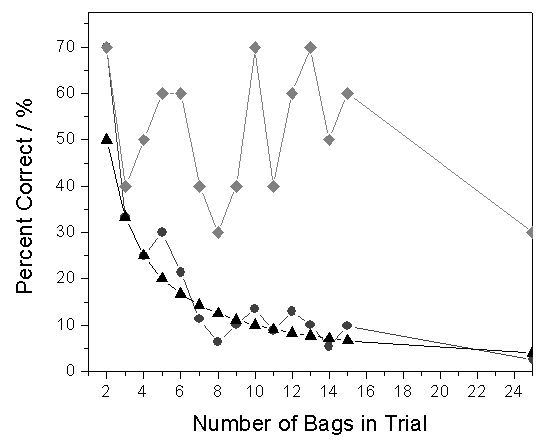 |

| |
The three box puzzle (also known as the "Monty Hall Problem") has brought many conversations about how to correctly choose the right box. In the simple puzzle - three boxes are shown to the contestant where they choose one. The host then removes a box he knows does not have the prize and ask the contestant to keep their first box or switch to the remaining box.
Statisically it has been proved many times over that the correct choice is to switch to the other box as it has a 66% chance of winning over the chosen box. However, in this experiment Scientific AmeriKen will enter another variable - information. What if after choosing the first box, the contestant than chooses the next box, sees that it is empty and then is offered an opportunity to switch? Answering this question may have significant implications for contestants of the TV game show Deal or no Deal and therefore must be studied! |

| |
The hypothesis of this experiment is that information gained from choosing incorrect boxes will play a role in the final decision. In Deal or no Deal the contestant chooses one box among 25 - a 4% chance of correctly choosing the $1,000,000 dollar box. As the game continues, boxes are chosen by the contestant and removed from the game and assuming the $1,000,000 case was not chosen, there will be a choice at the end between the original case and the remaining case. Although the originally chosen box only had a 4% chance of containing the prize, in support of the hypothesis, Scientific AmeriKen believes that if the prize was in the remaining 24 boxes that the chances of successfully avoiding that box 23 times also has a lower probability - thus the contestant should keep their original box. |

| |
To carry out this experiment a program written in flash was created (Shown below). The program lets a user set the number of bags to choose from, pick a bag, and then begin searching for the prize. Experiments were carried out between 2 and 15 bags as well as Deal or No Deal's 25. At each stage a bag was chosen and then picking would begin. If the prize was chosen before reaching the final two it was counted as a trial and the game restarted and if the game reached the final two bags it was considered an official trial. 10 official trials were held for each stage. |

| |
Results from this experiment are presented below. Triangles represent the theoretical percent correct of picking the correct bag from the total number of bags, Circles represent the percent correct from the total number of trials and squares represent the percent correct from 10 official trials for a given number of bags. Picking was performed as randomly as possible. |  |

| |
Surprising at the Deal or No Deal stage of 25 bags when the game reached the final 2 bags only 30% of the time was the big prize found in the originally picked bag. However at 30% it was significantly higher than the theoretical 4% likelihood of picking the correct box from the beginning. Overall the hypothesis that information plays a role in the final switch or no switch decision appears to be supported. A general impression from the data is that when a game reaches the final two bags it appears to have statistics similar to those seen in a coin flip. In conclusion, Scientific AmeriKen is confident in informing a Deal or No Deal contestant that if they were to reach that final decision that the choice between keeping their own case and switching out does not really matter.
Please continue to discuss your thoughts on this experiment at ScienceChatForum.com! |
|
 |
|

